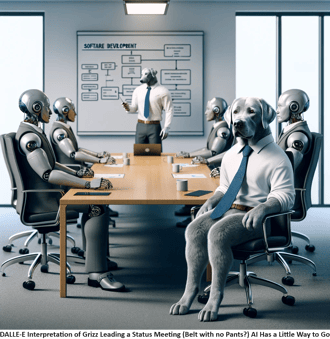Taking Notes: Insights on Microsoft's New Planner Collaborative Work and Task Management App
Chances are you already use Planner -after all it is the most utilized app in M365! You might have heard about Microsoft’s rollout of the new...

Over my 25-year career in #ProjectandPortfolioManagement, Software Development, and consulting, I have had the opportunity to see many organizations at different levels of performance and with different strengths and opportunities in the realm of #PPM and #WorkManagement. As I think back on those experiences, I am excited about what is on the horizon and the human value that #AI can bring to bear to overcome similar challenges and accelerate the achievement of higher performance, value realization, and even job contentment. And no, it is not the ability to create cute AI-generated dog pictures. Although clearly, that is of great value to us all.
 No, I am thinking of value that is a little more easily quantified. I once worked with an organization that would bring the distributed team together and spend a few days at the end of the year, talking about the year in review and what they wanted to accomplish over the next year. Year after year, they touted their achievements and lamented over those things they were unable to achieve because the team lacked the “margin” to devote time to the improvements they wanted and needed to make.
No, I am thinking of value that is a little more easily quantified. I once worked with an organization that would bring the distributed team together and spend a few days at the end of the year, talking about the year in review and what they wanted to accomplish over the next year. Year after year, they touted their achievements and lamented over those things they were unable to achieve because the team lacked the “margin” to devote time to the improvements they wanted and needed to make.
The organization had a culture of working harder rather than smarter. They were all too willing to pay consultants to advise them on their profitability challenges and tell them things their employees already knew they needed to do to improve, and to employ armies of people to manually collate information that was outdated by the time it was collected. I regularly witnessed multiple people on calls or in conference rooms collaboratively crafting PowerPoint presentations or emails. In one particularly offensive instance, I counted nine people co-creating an email. All the while, execs scratched their heads wondering why the efficiency ratio was upside-down.
However, it wasn’t that the individuals were incapable of writing the email. Rather, it was that the organization had built a culture that encouraged this kind of inefficiency, and it consumed the precious capacity of its talented and capable personnel. They were so busy doing things the way that they had always been done, that there was no margin left to envision what was possible or to devote the time and effort to build the improvements and automation recommended by the consultants and needed to eliminate the mind-numbing, monotony, and onerous redundancy and manual processes that had grown over time.
This is an extreme example, but it is not necessarily a unique one. Many organizations inadvertently consume the margin needed by their employees to envision the possible and implement improvements and efficiency gains that they already know need to be achieved. However, as I read the numerous articles on AI, I think about this organization and others that I have seen and believe that many of the articles miss the true power and value that AI should provide.
I entered the job market in the infancy of the Internet and e-commerce. My first job after University was connecting first-gen Web front ends to Financial Services mainframes. Now, if we saw any company without a web presence; well, we wouldn’t see that company, because they would no longer exist. I anticipate that shortly, AI will be very similar, in that all companies will be utilizing AI to the point that it will be permission-to-play and difficult to establish it as a differentiator in the market. Companies that fail to take this approach will likely go the way of companies that failed to embrace the Internet.
When I think about AI in Project and Portfolio Management specifically, it is exciting to hear statistics and claims like Gartner’s prediction that by the year 2030, AI will eliminate 80% of Project Management tasks. Like others in the space, my mind immediately goes to the deep insights and likely benefits of AI-suggested strategic portfolio investments, near real-time portfolio adaptations given projected market conditions, automated risk management and reporting, the efficiency of AI-driven resource utilizations, predictive analytics on effort success and benefit realization, scenario options for pivot or persevere and on and on.
All of these innovations and more will be disruptive, extremely valuable and will likely change the face of portfolio, project, and work management. But I wonder, once they become a foundational element to all good project and work management organizations and Portfolio Management Systems, what then?
The answer, I believe, is in the “margin.” When we allow AI to do what it can, the tasks that will be eliminated will be those that previously were the necessary evils within project and work management; the tasks that no one likes to do and to which everyone struggles to justify and ascribe value.
When these are handled or eliminated by AI, organizations will have a choice to make. They could remove the humans in the organization who were previously performing those tasks, admittedly reducing overhead, but relegating them to the performance status quo. They could redirect the time, effort, and cost of those humans to “oversee” the AI process and collectively generate PowerPoint presentations in a misguided attempt to keep the organization “human,” ultimately fostering a culture of atrophy and bloat. Or they could choose to unleash those skilled professionals and thought leaders to explore the newly created margin.
 Even when AI reaches the point at which it is truly foundational, we will likely still be faced with organizational silos and data islands that will require human interaction to identify and resolve. But, armed with this new margin of time, these thought leaders could be free to envision a new "possible," to identify and drive organizational improvement opportunities and create the connections, communications, and relationships that AI is ill-suited to fulfill, and which could propel their organizations to new levels of efficiency, effectiveness, and performance. When we allow AI to do what it can, high-performing organizations will be enabled in the margin, to focus their truly differentiating assets, their people, to do what AI can’t.
Even when AI reaches the point at which it is truly foundational, we will likely still be faced with organizational silos and data islands that will require human interaction to identify and resolve. But, armed with this new margin of time, these thought leaders could be free to envision a new "possible," to identify and drive organizational improvement opportunities and create the connections, communications, and relationships that AI is ill-suited to fulfill, and which could propel their organizations to new levels of efficiency, effectiveness, and performance. When we allow AI to do what it can, high-performing organizations will be enabled in the margin, to focus their truly differentiating assets, their people, to do what AI can’t.
If you would like to learn more about how to utilize AI to accelerate your company’s Journey to becoming a High-Performing Organization, I would encourage you to read Mike Taylor’s book, “The AI Project and Work Management Revolution is Here”, check out our AI centered articles, attend our upcoming WEBINAR: Modernizing Project Management with AI or schedule some time with us to discuss the new possible.
As always, if you have questions or need help connecting your systems, data, processes, and priorities to fully utilize #AI to create margin in your organization or need help building a world-class #PPM function and the processes and tools that enable it, please feel free to reach out to me. I would love to hear what I can do for you. I am happy to be of service.

Chances are you already use Planner -after all it is the most utilized app in M365! You might have heard about Microsoft’s rollout of the new...

One of the things that we’re talking to people about is getting the best advantage out of using AI for project and work management. We see many of...

Over my 25-year career in #ProjectandPortfolioManagement, Software Development, and consulting, I have had the opportunity to see many organizations...